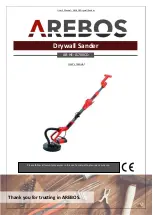
User’s Manual
–
A
REBO
S Drywall Sander
12
CARBON BRUSH REPLACEMENT
•
The accessories include an original set of carbon brush, when the carbon brush reaches its
wear limit, replace with a new one. Use a "+" screwdriver counter-clockwise to unscrew the
brush cover, remove the original carbon brush, place a new carbon brush and screw the
brush cover.
TO START AND STOP DRYWALL SANDER
•
Make sure power circuit voltage is the same as shown on the specification plate on the
Sander, and that the Sander switch is OFF. Connect Sander to power circuit.
The Drywall Sander is equipped wit
h a “rocker” type switch. The t
op end of the switch button
is labeled OFF, and the bottom end of the button is labeled ON. To start the Sander: press
the bottom (ON) end of the switch button, to stop the Sander press the top (OFF) end of the
switch button.
SANDING DRYWALL
•
The Drywall Sander has a unique articulating sanding head allowing the abrasive pad to
conform to the work surface.
•
This enables the operator to sand the top, middle and bottom of a wall or ceiling joint.
•
When sanding the tall wall, and ceiling, please use a ladder for help.
•
The sanding pad can adjust to the height by itself when it meets an uneven wall.
1.
CAUTION:
Wear a respirator approved for "Dust and Mist".
2.
Turn Drywall Sander switch 0N.
3.
Position Drywall Sander lightly against work surface (apply just enough pressure to align the
sanding head with the work surface).
4.
Apply additional pressure to engage the abrasive pad to the work surface: while moving the
Sander in an overlapping pattern to smooth the drywall compound down to a "featheredge'.
Apply ONLY enough pressure to keep the abrasive pad flat against the work. Excessive
pressure can cause unacceptable swirl marks and unevenness in the work surface.
Keep the Sander in constant motion while abrasive pad is in contact with the work surface.
Use a steady, sweeping motion. Stopping the Sander (on the work), or moving the Sander
erratically can cause unacceptable swirl marks and unevenness in the work surface.
•
NOTE:
Do not allow rotating abrasive pad to contact sharp protrusions. Contact with
protruding objects (nails, screws, electrical boxes, etc.) can severely damage the abrasive
pad.














